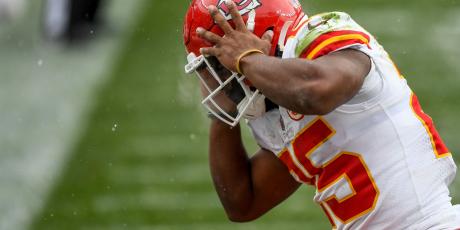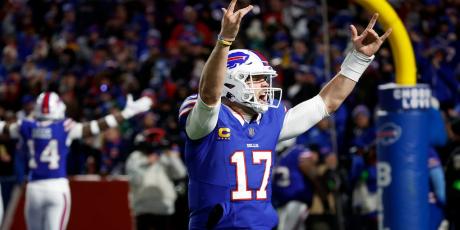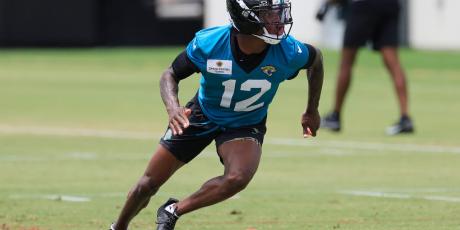Marshawn Lynch's Handcuff: DeAndre Washington or Jalen Richard?

DeAndre Washington and Jalen Richard were far more efficient than Latavius Murray on the ground last year; can they also be more efficient than Marshawn Lynch this year? We may have to just wait and see what Lynch has to offer before we get another chance to see either second-year back in an extended role, but is either of them worthy of a late-round fantasy pick?
I was a fan of Washington last season, and now his draft stock has fallen even further with the presence of Beast Mode. Naturally, when the public tends to do one thing I tend to look into the viability of the other -- and I was pleasantly surprised at what I found. Both Washington and Richard were used similarly in complementary roles last season in Oakland, with Washington getting a bit more early-down work and Richard getting more third-down work and returning kicks. While it could ultimately end up being a frustrating season for both -- their value is fragile because it's dependent on Lynch getting injured or proving ineffective -- they're both dirt cheap and carry a ton of upside.
Will the Raiders get a full season from Lynch? Would Washington or Richard have RB1 upside if thrust into a bigger role? Most importantly, which one is the better handcuff?
My Rushing Expectation charting, which balances metrics with film evaluation (one of the toughest things to do in fantasy football), can provide some clues as to how to attack the Raiders' backfield in 2017 fantasy drafts.
Sign up with 4for4 to gain access to every single Rushing Expectation profile of 2017!
A Note About Sample Size
Both Washington and Richard fell under the limited sample size category in 2016 even though they both have over well over 100 potential touches. You can read more about how I form sample size here, but ultimately neither of them satisfied the criteria for a "normal" sample.
The good news is, per those set guidelines, I have charted every potential touch from the entire season for both Washington and Richard, with the caveat being some of those touches come from games in which they touched the ball infrequently, so game flow and situation may not be completely representative of their capabilities as a potential feature back.
With that out of the way, I’ll let TJ Hernandez transition us to the good stuff in the same way he prepared me to watch Washington’s first touch; I strongly recommend you take his advice:
Rushing Expectation: DeAndre Washington
What stands out immediately about Washington is he has very good burst and rare acceleration. The big-play upside is there on paper as well -- 8.1 percent of his rushing attempts went for 15 yards or more last season, fifth-highest in the NFL.
In charting Washington, I saw a running back with above-average athletic ability and very good elusiveness through tight creases. This meshes well with his rare speed, as he can routinely make it to the second level before defenses have time to react.
Washington consistently shows good patience and above-average discipline on inside runs, but on the rare occasion he bounces a run outside his acceleration almost hurts him, as he loses his blocks too quickly -- which explains why he fell below expectation in every rushing direction but through the middle (although those attempts accounted for just 26.4 percent of his carries.)
The Raiders' overall Expected Success Rate in '16 on rushing attempts was 46.2 percent, nearly identical to the NFL average of 46.3 percent. This may be surprising to some, but let’s not forget my metric is based off of Adjusted Line Yards and Team Success Rate, with the former assigning a certain amount of responsibility to the offensive line for every rush based on length, rather than being a traditional offensive line “grade.” That being said, Washington has been most successful running through the middle, which is by far his largest sample.
The Raiders were also slightly below average at blocking for targets to running backs, with an Expected Success Rate of 41.7 percent -- three percent below the league average.
While Washington may be stuck in a timeshare with Richard in the passing game, that's where some of Washington’s best work has come. He has above-average receiving ability, catching balls with his hands, adjusting well to difficult angles, and battling in tight coverage. It just shows how dynamic he can be when the Raiders target him on short, high-percentage plays where his rare athletic ability and big-play upside can shine through.
Although his power is merely average, Washington does some great things between the tackles on the shoulders of his rare athletic ability and above-average mental processing. His balance can be inconsistent, but this is one of those cases where I objectively see room for him to grow into more than just a big-play weapon.
The primary reasons for my optimism are Washington's strong output in yards before and after contact, as well as his efficiency in subpar defensive situations. Despite facing eight or more in the box at a rate which ranked in the 71st percentile, Washington finished in the 84th and 86th percentile in yards before and after contact, respectively -- not to mention his Success Rate was 15.8 percent higher against eight or more in the box than against seven or fewer.
Yards per carry/target can be a stat that is highly skewed by big plays, which is why I prefer to use Success Rate. The argument against Washington’s efficiency is that it is probably due to a limited sample size being skewed by big plays, but like Spencer Ware, I believe that concern is completely alleviated because of what I saw in the open field and through contact. Like Ware, Washington made big plays happen -- they didn’t happen to him. This stuff matters when looking for a high ceiling in the late rounds of fantasy drafts.
Overall, charting Washington has provided two noteworthy takeaways:
-
Given his potentially elite athletic ability, strong performance in key metrics like yards before/after contact, and proficiency against eight or more in the box and up the middle, Washington still has room for growth as a runner and should have no problem improving on runs to the outside.
-
Given his room for grwoth as a runner and his pass-catching ability, Washington could be more than just complementary big-play threat.
That said, an appealing arbitrage play off of Washington could easily be in the same backfield -- and I’m not talking about Beast Mode.
Rushing Expectation: Jalen Richard
When looking for potential Zero RB candidates, two key components are pass-catching ability and situational upside. I actually graded Washington higher as a pass catcher, but Richard could easily carry more short-term value in the passing game -- he received 2.4 targets per game to Washington's 1.6. Richard also ran well between the tackles on limited attempts:
Richard's Pro Day metrics -- namely his SPARQ and agility score -- are incredibly poor, which is perplexing given the fact that he returns both punts and kicks for the Raiders. While that makes zero sense on paper, it implies trust from the coaching staff, so I was eager to dig into the film and form my own evaluation beyond his Pro Day performance.
Washington is significantly faster than Richard, but Richard still has above-average burst and good speed on film. I also found Richard's agility and elusiveness to be criminally underrated, especially given his Pro Day metrics. He finished in the 93rd percentile in yards before contact on the ground; athletes that forever belong in the zero-percentile-SPARQ-score-purgatory don’t do that. And while Washington was fifth in the NFL in regards to percentage of rushing attempts over 15 yards, Richard wasn't far behind, finishing ninth in that same category (7.1 percent).
Richard’s touches on the ground were relatively spread out, though like Washington, he did run to the middle and left tackle at the highest rate; running anywhere in the vicinity of first-team All-Pro left guard Kelechi Osemele seems like a good idea. Richard's power is above average -- probably better than Washington’s -- and I was impressed with his low pad level.
Part of the reason I graded Washington as a better receiver than Richard is that Richard's efficiency through the air was in the 10th percentile relative to my 60-player sample; his efficiency on targets to the inside and outside areas of the field was pretty pathetic. That said, his football instincts are very good, in particular when lined up out wide.
I’m am a bit skeptical that Richard’s before-contact yardage may be skewed because of strong offensive line play, as well as from facing seven or less in the box frequently (he faced eight or more in the box just 20 times in my charting sample, and his Success Rate was naturally much higher in those more favorable situations). This is a big point in favor of Washington, as both he and Richard have similar Expectation Scores, but against drastically different defensive fronts overall. Richard also creates far less after contact than Washington.
Overall, charting Richard has provided three noteworthy takeaways:
-
Richard's agility and speed are underrated relative to his Pro Day metrics.
-
The majority of Richard’s runs came against soft boxes, but in a small sample he looked good between the tackles.
-
Although the coaching staff seems to prefer Richard in the third-down role, he's not as good of a receiver as Washington.
Is all this moot? After all, Marshawn Lynch is back baby!
Will Marshawn Lynch Return to Beast Mode?
There is not much to be said about Lynch really -- he carries a ton of risk and uncertainty, especially for a player with an ADP threatening the second round in fantasy drafts. In addition to various incentive-based bonuses, Lynch will receive $1.35 million guaranteed, but the last time we saw him, he struggled to stay healthy and produce (in a situation Thomas Rawls crushed, by the way).
Doing Skittles commercials in his retirement didn’t magically make Lynch become a better pass catcher, which should open the door for possible weekly viability from Washington and/or Richard in fantasy.
There are not many better situations in the league than what the Raiders have as far as quarterback stability and offensive line, but with the uncertainly surrounding Lynch's ability to bounce back, I will be erring to the side of caution, investing instead in Washington and Richard, who are cheaper, lower-risk options with higher upside relative to their cost.
Related: How Effective Will Marshawn Lynch Be in 2017?
What About Elijah Hood?
I’m not worried at all about Elijah Hood, a seventh-round rookie who has "turned the heads of the offensive staff" at rookie mini-camp. He’s a backup-level talent with little appeal outside of a few short-yardage touchdowns this season in a fullback-type role.
DeAndre Washington: 2017 Fantasy Outlook
Given Washington’s talent, if Lynch were to get injured, it would not be surprising to see Washington take the opportunity and never look back. Regardless, I fully expect his rushing efficiency to improve given key his ability to create yardage and run against stacked fronts -- he should be able to become more than just a big-play weapon behind one of the top offensive lines in the league.
I’m buying Washington, especially in PPR formats. At his ADP, he's essentially free, so there is little risk and a ton of upside. Since Washington did better in my charting than Richard and has more upside as an all-around back, I'd lean towards treating him as Lynch's primary handcuff.
Jalen Richard: 2017 Fantasy Outlook
TJ and I talk a lot, so I’ll leave you guys the same way as I brought you in:
I actually went with this in #SFB7, getting Washington in the 15th round and Richard in the 17th round. There’s a chance Washington and Richard will share the backfield even if Lynch goes down, but scooping up both would be a great dart to throw in a high-upside situation.
The Raiders designed a role for Richard as a receiver and returner last season, and despite his athletic profile, he probably doesn’t get the credit he deserves between the tackles. Though I believe he is underrated, he's more likely to continue making the most impact in the return game, and I'm still leaning towards Washington as Lynch's primary handcuff, which probably limits Richard to Zero RB appeal.
Note: Use our ADP tool to see the most up-to-date ADP on Lynch, Washington, and Richard, and our rankings (updated daily) and customizable cheat cheets to plan for your 2017 fantasy draft.
Sign up with 4for4 to gain access to every single Rushing Expectation profile of 2017!
Related Articles:
- How Effective Will Marshawn Lynch Be in 2017?
- Why You Should Avoid the Vikings' Backfield in Fantasy Football
- Spencer Ware's League-Winning Fantasy Upside is Being Ignored
- 7 Running Backs With an Easy Fantasy Strength of Schedule
- Bilal Powell is the Jets Back to Own Because Matt Forte is Trash Now
- Todd Gurley Isn't Worth Your Second-Round Fantasy Pick
- Ty Montgomery Has Massive Fantasy Upside
- Uh-Oh, Christian McCaffrey Could be a Bust
- Ameer Abdullah is the Lions Running Back to Own in Fantasy
- Does Isaiah Crowell or Duke Johnson Offer More Fantasy Value?
- Rushing Expectation 2017: An Introduction
- The Fantasy Value of Patriots Running Backs Mike Gillislee, James White, Dion Lewis & Rex Burkhead
- Stop Taking Adrian Peterson Over Mark Ingram in Fantasy
- 6 Reasons Jordan Howard Will Not Be a Fantasy Football Bust
- Using Red Zone Expected Value to Find 5 Running Back Touchdown Regression Candidates
- What are the Most Predictable Year-to-Year Stats for Running Backs?
- Leonard Fournette, Samaje Perine & the Other Rookies That Will Make a Fantasy Impact in 2017
- When Should You Draft Your Running Back?
- How Often Do Top-12 PPR Running Backs and Wide Receivers Repeat the Following Season?
- 2017 Initial Rankings: A Closer Look at Bilal Powell, Danny Woodhead and Theo Riddick
- What the Move to Philadelphia Means for LeGarrette Blount
- Danny Woodhead Had RB1 Upside at This Time Last Year - Does He Still?






















